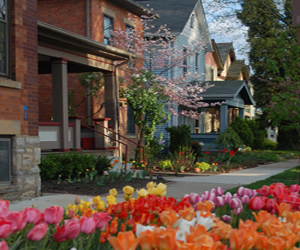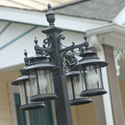On Putting Your Garden to Bed
By Bob Mangia
When it comes to planning what you want to see in your garden next spring, fall is a great time for reflection. Take note of how plants performed this year, and start to think about next year’s display while this year’s is still fresh in your mind. Take a walk around the neighborhood to remind yourself what you liked in your neighbors’ yards and to get inspiration for your own. Then dig in. Preparation today makes for a great garden tomorrow.
The first thing to do when putting your garden down for the winter is to strategize your plan of attack. Starting with a list will simplify your fall cleanup. Common fall chores are clearing away debris, cutting back perennials, pulling out annuals and vegetables, clearing out beneath shrubs and trees and pruning them as necessary. The library and Internet have great references for when you’re in doubt about how far back to cut that bush or how to divide those bulbs. Keep in mind, too, that some plants’ displays may be finished, but they can stand up to the winter, providing texture to your garden or supplying birds with food. Why not leave your zebra grass or your black-eyed Susans for a while?
“Patience is a virtue,” it’s true, and bulbs make all of us virtuous! Though the payoff seems an eternity away, fall is the time to plant spring bulbs. The warm soil and cool air creates the perfect environment for bulb root development. Remember that crocuses are early risers, so treat yourself to a few and your reward will come even sooner. This is also a good time to transplant trees and shrubs. Again, the library and Internet have great information on how to transplant individual species.
Now is the time to clean around your house’s foundation to keep hungry critters away from (and out of) your home. It’s also a good time to fertilize, reseed and repair your lawn. And just because it’s fall and the days may be getting cool, don’t forget to water. Plants in moist soil (be careful not to waterlog the soil, though) tend to survive the winter best. You can also add organic material—compost or manure—now to improve the soil structure and keep some of the summer’s heat in the ground.
Fall is also a good time for those occasional garden-maintenance tasks: repairing and repainting trellises, for example. Fire pits and fountains should be cleaned up and put away; sidewalk and driveway maintenance should be considered.
As fall progresses, you should also plan to regularly remove fallen leaves from beds. Removing the leaves from your lawn will help it to remain healthy, and clearing the walks throughout the fall will make shoveling snow from them easier and walking on them safer in the winter. (Lots of leaves fall in the street, too, of course; don’t forget that streets in Harrison West will be cleaned on the second Tuesday and Wednesday of November.)
If you have the space to do so, why not set up a compost area this fall and add to it all the organic debris you’ve raked and pruned? You’ll have fertile material to spread on your beds next spring. If you are unable to compost, you should bag your yard waste or put in marked cans for disposal. The city prohibits residents from putting yard waste in the green refuse dumpsters. Bagged yard waste is picked up at the street—not by dumpsters—on your area’s regular recycling day.
Remember landscape maintenance has four seasons, and you’re going to be doing this again next fall. Pay attention to how you’re performing your fall tasks now—what’s going well and what’s a pain—and think about how you can make things easier for yourself next time around. Then pour yourself a cup of hot chocolate and settle in for the winter.


 October 13, 2010
October 13, 2010 














No comments yet... Be the first to leave a reply!